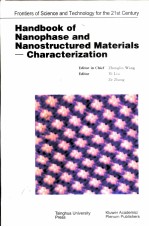图书介绍
纳米相和纳米结构材料-结构和性能表征手册PDF|Epub|txt|kindle电子书版本网盘下载

- 王中林,刘义,张泽主编 著
- 出版社: 北京:清华大学出版社
- ISBN:7302054428
- 出版时间:2002
- 标注页数:388页
- 文件大小:34MB
- 文件页数:413页
- 主题词:
PDF下载
下载说明
纳米相和纳米结构材料-结构和性能表征手册PDF格式电子书版下载
下载的文件为RAR压缩包。需要使用解压软件进行解压得到PDF格式图书。建议使用BT下载工具Free Download Manager进行下载,简称FDM(免费,没有广告,支持多平台)。本站资源全部打包为BT种子。所以需要使用专业的BT下载软件进行下载。如BitComet qBittorrent uTorrent等BT下载工具。迅雷目前由于本站不是热门资源。不推荐使用!后期资源热门了。安装了迅雷也可以迅雷进行下载!
(文件页数 要大于 标注页数,上中下等多册电子书除外)
注意:本站所有压缩包均有解压码: 点击下载压缩包解压工具
图书目录
1 X-ray and Neutron Scattering1
1.1 Introduction1
1.2 X-ray and Neutron Diffraction4
1.3 Inelastic Neutron Scattering14
1.4 Small Angle Scattering21
1.5 Concluding Remarks24
References25
2 Transmission Electron Microscopy and Spectroscopy29
2.1 Major Components of a Transmission Electron Microscope29
2.2 Atomic Resolution Lattice Imaging of Crystalline Specimens31
2.2.1 Phase Contrast31
2.2.2 Abbe’s Imaging Theory32
2.2.3 Image Interpretation of Very Thin Samples34
2.2.4 Image Simulation34
2.3 Faceted Shapes of Nanocrystals37
2.3.1 Polyhedral Shapes of Nanoparticles37
2.3.2 Twinning Structure and Stacking Faults41
2.3.3 Decahedral and lcosahedral Particles42
2.3.4 Nucleation and Growth of Nanoparticles43
2.4 Electron Holography46
2.5 Lorentz Microscopy48
2.5.1 Principle of Lorentz Microscopy48
2.5.3 Fresnel Lorentz Microscopy49
2.5.2 Elimination/Reduction of Magnetic Field from Objective Lens49
2.5.4 Foucault Lorentz Microscopy50
2.5.5 Differential Phase Contrast Mode of Lorentz Microscopy in STEM51
2.6 Nanodiffraction52
2.6.1 Optics for Nanodiffraction53
2.6.2 Experimental Procedures to Obtain a Nanodiffraction Pattern53
2.6.3 Some Applications54
2.7 In situ TEM and Nanomeasurements61
2.7.1 Thermodynamic Properties of Nanocrystals62
2.7.2 Nanomeasurement of Electrical Transport in Quantum Wires68
2.7.3 Nanomeasurement of Mechanical Properties of Fiber-Like Structures70
2.7.4 Femtogram Nanobalance of a Single Fine Particle71
2.7.5 Electron Field Emission from a Single Carbon Nanotube72
2.8 Electron Energy Loss Spectroscopy of Nanoparticles75
2.8.1 Valence Excitation Spectroscopy75
2.8.2 Quantitative Nanoanalysis77
2.8.3 Near Edge Fine Structure and Bonding in Transition Metal Oxides79
2.8.4 Doping of Light Elements in Nanostructures81
2.9 Energy-Filtered Electron Imaging85
2.9.1 Chemical Imaging of Giant Magnetoresistive Multilayers85
2.9.2 Imaging of Spin Valves89
2.9.3 Mapping Valence States of Transition Metals91
2.10 Energy Dispersive X-ray Microanalysis(EDS)93
2.11 Summary94
References95
3 Scanning Electron Microscopy99
3.1 Introduction99
3.2 Basic Principals of Scanning Electron Microscopy100
3.2.1 Main Parameters of Electron Optics101
3.2.2 The Minimum Attainable Beam Diameter102
3.3 Contrast Formation and Interpretation103
3.4 Secondary Electron Detectors111
3.4.1 Everhart-Thornley Detector111
3.4.2 In-iens Secondary Electron Detector112
3.5 Dedicated Detectors114
3.5.1 Solid-State Diode Detector114
3.5.2 Scintillator Backscattered Electron Detector115
3.5.3 BSE-to-SE Conversion Detectors115
3.5.4 Multi-detector System115
3.5.5 Electron Backscattered Diffraction(EBSD)116
3.5.6 Magnetic Contrast117
3.5.7 X-ray Spectrometers118
3.6 Conclusions120
References121
4.1 Overview124
4 Scanning Probe Microscopy124
4.2 Scanning Tunneling Microscopy125
4.2.1 Introduction125
4.2.2 STM Studies on Metals127
4.2.3 STM Studies on Semiconducting Surfaces130
4.2.4 Organic Molecules Studied by STM135
4.3 Atomic Force Microscopy138
4.3.1 Introduction138
4.3.2 The Force Sensor139
4.3.3 lllustration of AFM Applications141
4.3.4 Force Spectrum Analysis144
4.3.5 Lateral Force Microscopy146
4.3.6 Force Microscope operating in Non-contact Mode147
4.3.7 Force Microscope Operating in Tapping Mode148
4.3.8 Magnetic Force Microscopy150
4.4 Ballistic-Electron-Emission Microscopy152
4.4.1 The Principle of BEEM152
4.4.2 BEEM Experiments154
4.4.3 Ballistic-Hole Spectroscopy of Interfaces156
4.5 Applications of STM and BEEM in Surface and Interface Modifications159
4.5.1 Surface Nanofabrication with STM160
4.5.2 Single Atom Manipulation164
4.5.3 Interfacial Modification with BEEM166
4.6 Concluding Remarks167
References168
5 Optical Spectroscopy172
5.1 Introduction172
5.2 Nanoclusters and Nanocrystals173
5.2.1 Absorption and Photoluminescence Spectroscopic Evidence for Quantum Confinement174
5.2.2 Raman and FTIR Studies on the QDs and Its Supramolecular Assemblies181
5.2.3 High Resolution Spectroscopy of Individual Quantum Dots184
5.2.4 Ultrafast Spectroscopy in Quantum Confined Structures192
5.3.1 Processing on the Nanostructures197
5.3 The Control of Nanostructures by Spectroscopic Diagnosis197
5.3.2 Spectroscopic Diagnosis201
5.3.3 Photovoltage Spectroscopy of Surface and Interface212
References215
6 Dynamic Properties of Nanoparticles219
6.1 Introduction219
6.2 Experimental Techniques220
6.2.1 Synthesis of Semiconductor Nanoparticles220
6.2.2 Synthesis of Metal Nanoparticles222
6.2.3 Characterization of Nanoparticles222
6.2.4 Dynamics Measurements with Time-Resolved Techniques223
6.3.1 Theoretical Considerations225
6.3 Dynamic Properties of Semiconductor Nanoparticles225
6.3.2 CdS,CdSe and Related Systems228
6.3.3 Metal Oxide Nanoparticles:TiO2,Fe2O3,ZnO,SnO2231
6.3.4 Other Semiconductor Nanoparticle Systems:Si,Agl,Ag2S,PbS234
6.3.5 Nanoparticles of Layered Semiconductors:MoS2,Pbl2235
6.3.6 Effects of Particle Surface,Size and Shape237
6.4 Dynamic Properties of Metal Nanoparticles238
6.4.1 Background and Theoretical Considerations238
6.4.2 Gold(Au)Nanoparticles240
6.4.3 Other Metal Nanoparticles:Ag,Cu,Sn,Ga and Pt242
6.4.4 Effects of Surface,Size and Shape242
6.5 Summary and Prospects243
References244
7 Magnetic Characterization252
7.1 Introduction252
7.2 SQUID Magnetometry255
7.3 M(?)ssbauer Spectroscopy262
7.4 Neutron Powder Diffraction273
7.5 Lorentz Microscopy277
7.6 Summary281
References281
8 Electrochemical Characterization283
8.1 Introduction283
8.2.1 Electrodeposition and Electrophoretic Deposition285
8.2 Preparation of Nanostructured Electrode285
8.2.2 Formation of Nanoparticles in Polymers287
8.2.3 Electrochemical Self-Assembly288
8.2.4 Mesoporous Electrodes289
8.2.5 Composite Electrodes Consisting of Nanoparticles291
8.2.6 Powder Microelectrode291
8.3 Principles of Electrochemical Techniques293
8.3.1 Impedance Spectroscopy293
8.3.2 Potential Sweep Method300
8.3.3 Potential Step Method304
8.3.4 Controlled-Current Techniques307
8.3.5 Electrochemical Quartz Crystal Microbalance312
8.4 Application to Nanostructured Electrodes316
8.4.1 Characterizing the Reversibility of Battery Electrode Materials316
8.4.2 Characterizing the Transport Properties319
8.5 Summary320
References321
9 Mechanical Property Characterization326
9.1 Elasticity Study of Metal Nanometer Films326
9.1.1 Vibrating Reed Method326
9.1.2 Elasticity Measurements on Ag and Al Films328
9.1.3 Supermodulus Effect in Ag/Pd Multilayers332
9.2 Mechanical Behavior of High-Density Nanocrystalline Gold336
9.3.1 Introduction348
9.3 FIB/TEM Observation of Defect Structure Underneath an Indentation348
9.3.2 FIB Milling349
9.3.3 Experimental Procedures349
9.3.4 Load-Displacement Curve349
9.3.5 TEM Observation352
9.3.6 Conclusion355
References355
10 Thermal Analysis358
10.1 Introduction358
10.2 Fundamental Techniques359
10.3 Experimental Approach364
10.3.1 Melting of Nanophases and Nanostructured Materials365
10.3.2 Kinetics of Glass-Nanocrystal Transition and Grain Growth of Nanostructured Materials366
10.3.3 Heat capacity of Nanostructured Materials369
10.3.4 Interface Enthalpy of Nanostructured Materials370
10.4 Data Interpretation372
10.4.1 Size-Dependent Melting Thermodynamics of Nanophases372
10.4.2 Glass-nanocrystal Transition Thermodynamics374
10.5 Examples of Applications374
10.6 Limitalions382
10.7 Prospects383
References384
Index386